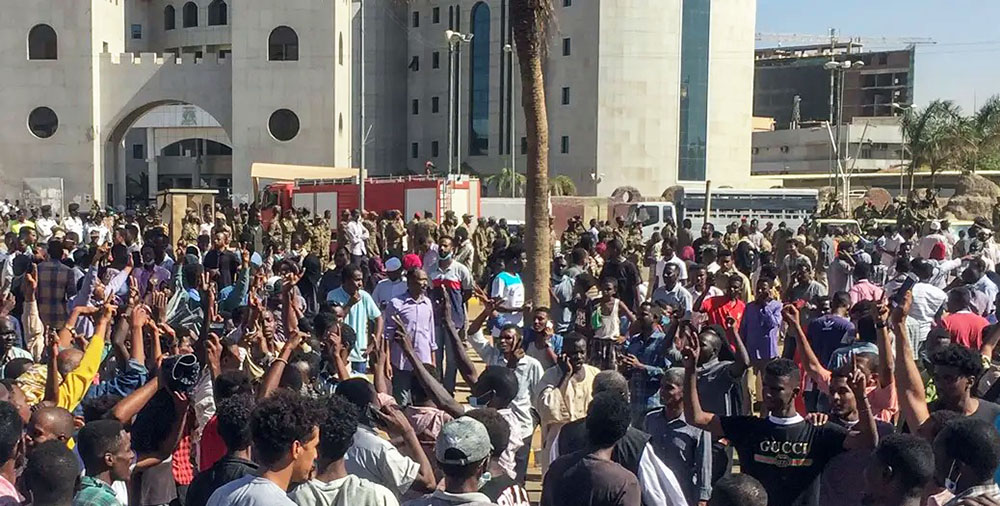
The Sudanese Army: Military Doctrine and the Absence of the State 4-4
By Ameer Babiker Abdalla
It was only natural that Lieutenant General Abdel Fattah al-Burhan’s coup against the Constitutional Document would succeed. He removed the other party from the political scene by force, annulled parts of the "Constitutional Document" that didn’t align with his ambitions, and retained those that didn’t affect the broader picture, keeping a semblance of cooperation with the regional and international actors who pressured for its approval. It was natural for this to succeed because the state was already primed for it, given its deliberate absence—just as all previous coups that overthrew democratic regimes had succeeded.
Here, I reiterate a point I often make: coups led by the military always succeed in toppling democratic regimes, but military coups fail to overthrow regimes governed by the military. These military regimes are usually overthrown by popular mass uprisings.
Al-Burhan didn’t cancel the "Constitutional Document" outright. Instead, he suspended the articles that legitimized the presence of the second party in power, the Forces of Freedom and Change. All these articles were related to power-sharing, not the state itself, including the formation of the Sovereignty Council, the cabinet, and the legislative council, which never came into existence. He also suspended the article regarding the Constitutional Document’s authority. All of this was done while al-Burhan wore his full military uniform, making a decision that was political in both essence and appearance. However, this coup, which al-Burhan called a "reform," didn’t come against a temporary constitution but a temporary constitutional document governing a transitional regime, not an elected one. This is the first coup of its kind in Sudan, where the head of the Sovereignty Council overthrew his executive body.
This move revealed the absence of a comprehensive state doctrine, resulting in the failure to form the necessary executive and legislative bodies, and leading to political, economic, and security turmoil. The state and its institutions, flawed as they may have been, fell into confusion, lacking any guiding principles to govern relationships and maintain order. Naturally, the people were left out of the equation, with their interests ignored. The military, the primary institution in this entire scenario, suffered the most from the absence of the state and its doctrine.
In these precarious circumstances, war broke out—a war both leaders described as "futile." The armed forces found themselves surrounded on all sides by the Rapid Support Forces (RSF), which had built a combat structure nearly matching that of the army, except for the lack of some support weapons. I won’t delve into the RSFs history, the reasons for its formation, or its expansion—everyone knows the story. What needs to be emphasized is that its rise, existence, and expansion, along with its growing power, were the natural outcomes of the states absence and the lack of a comprehensive doctrine, one of the key factors weakening the armed forces.
More dangerously, the army found itself without a state to protect it politically, diplomatically, or through the media. All institutions collapsed after the first shot was fired on April 15, 2023. The army was left without a comprehensive doctrine from which to draw its vision and without a solid military doctrine to rely on. It was pulled between different factions trying to use it for political gains, thrust into a war for which it wasn’t adequately prepared. By its nature, the military had to fight those it considered its allies in the same trenches until the eve of the war, simply because orders were given to fight.
In countries with well-established institutions, during emergencies or wartime, these institutions know how to manage their affairs and support their armies. Despite the bitterness of this reality, it places everyone in front of the responsibility for the future. A state and its institutions shouldn’t be affected by the exchange or change of power. They are meant to be permanent, national, and serve everyone, while power is subject to change. In Sudan’s case, past and present, power has been subject to coups. Blaming one party for this severe decline of the state isn’t enough. The responsibility must be shared by all if we are to build a consensual and cohesive state. This responsibility is inherited, and there’s no escaping it except through achieving a national project.
Talking about the army and the political infiltration it has experienced throughout its history is evidenced by many instances. Discussing the army’s unity, reform, restructuring, and strengthening is not only inaccurate but also dishonest and "political manipulation." Without accomplishing a national project agreed upon by all the people of Sudan, drafting constitutional principles according to that project, and creating a constitution put to a public referendum and passed by an elected parliament that sets the foundation of a comprehensive state doctrine, discussions of a unified army and its reform and restructuring are mere rhetoric. The military institution is part of the state’s institutions, and we can’t talk about reforming it or any other state institution without a general vision of the state we want to live under. Discussing institutional reforms in isolation is futile, like repainting a car while its engine remains broken, and its tires are unfit for service.
Talking about a military doctrine for the armed forces in the absence of a comprehensive state doctrine is incomplete. Sudan is in dire need of a military doctrine that reflects the states security and defense needs, especially given its geographic location at the heart of Africa, its borders with seven countries, and its potential geopolitical influence if it can set its steps firmly on the path to internal stability, protected by a strong, unified army. We need a unified military doctrine for the armed forces, so they aren’t distracted by internal issues and rebellions but instead draw their strength from the state’s capabilities and derive their cohesion and authority from a unified internal front that supports them.

